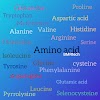Cysteine | History | Structure | Biosynthesis | Function.....
CYSTEINE AMINO ACID
Cysteine (symbol Cys or C) is a semiessential proteinogenic amino acid.
Or
Cysteine is a non-essential sulfur-containing amino acid in humans, related to cystine, Cysteine is important for protein synthesis, detoxification, and diverse metabolic functions.
Found in beta-keratin, the main protein in nails, skin, and hair, Cysteine is important in collagen production, as well as skin elasticity and texture. The thiol side chain in cysteine often participates in enzymatic reactions, as a nucleophile. The thiol is susceptible to oxidation to give the disulfide derivative cystine, which serves an important structural role in many proteins. When used as a food additive, it has the E number E920. It is encoded by the codons UGU and UGC. Cysteine has the same structure as serine, but with one of its oxygen atoms replaced by sulfur; replacing it with selenium gives selenocysteine. Like other natural proteinogenic amino acids, cysteine has l chirality in the older d/l notation based on homology to d- and l-glyceraldehyde.
Properties :-
Chemical formula :- C3H7NO2S
Molar mass :- 121.15 g·mol−1
Appearance :- white crystals or powder
Melting point :- 240 °C (464 °F; 513 K) decomposes
Thermodynamic data :- Phase behaviour (solid–liquid–gas)
Structure :-
In animals, biosynthesis begins with the amino acid serine. The sulfur is derived from methionine, which is converted to homocysteine through the intermediate S-adenosylmethionine. Cystathionine beta-synthase then combines homocysteine and serine to form the asymmetrical thioether cystathionine. The enzyme cystathionine gamma-lyase converts the cystathionine into cysteine and alpha-ketobutyrate. In plants and bacteria, cysteine biosynthesis also starts from serine, which is converted to O-acetylserine by the enzyme serine transacetylase. The enzyme cysteine synthase, using sulfide sources, converts this ester into cysteine, releasing acetate.
Dietary source :- Like other common amino acids, cysteine (and its oxidized dimeric form cystine) is found in high-protein foods. Although classified as a nonessential amino acid, in rare cases, cysteine may be essential for infants, the elderly, and individuals with certain metabolic diseases or who suffer from malabsorption syndromes. Cysteine can usually be synthesized by the human body under normal physiological conditions if a sufficient quantity of methionine is available. Like other amino acids, in its monomeric "free" form (not as part of a protein) cysteine has an amphoteric character.
Industrial source :- The majority of l-cysteine is obtained industrially by hydrolysis of animal materials, such as poultry feathers or hog hair. Despite widespread belief otherwise, little evidence shows that human hair is used as a source material and its use is explicitly banned in the European Union. Synthetically produced l-cysteine, compliant with Jewish kosher and Muslim halal laws, is also available, albeit at a higher price. The synthetic route involves fermentation using a mutant of E. coli. Degussa introduced a route from substituted thiazolines. Following this technology, l-cysteine is produced by the hydrolysis of racemic 2-amino-Δ2-thiazoline-4-carboxylic acid using Pseudomonas thiazolinophilum.







0 Comments